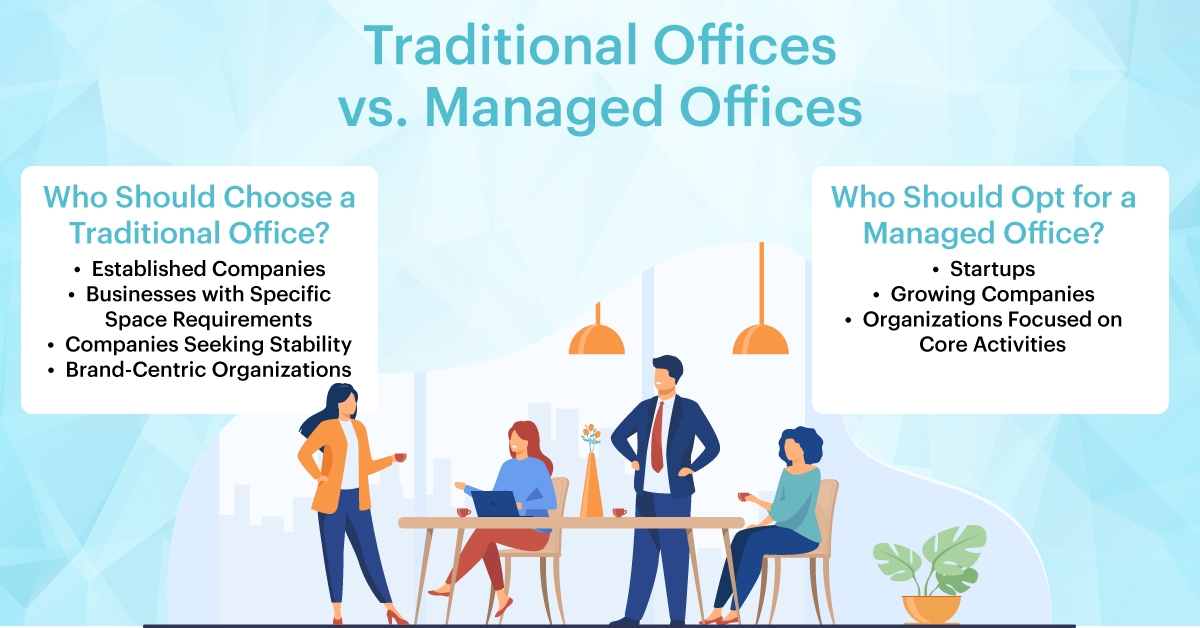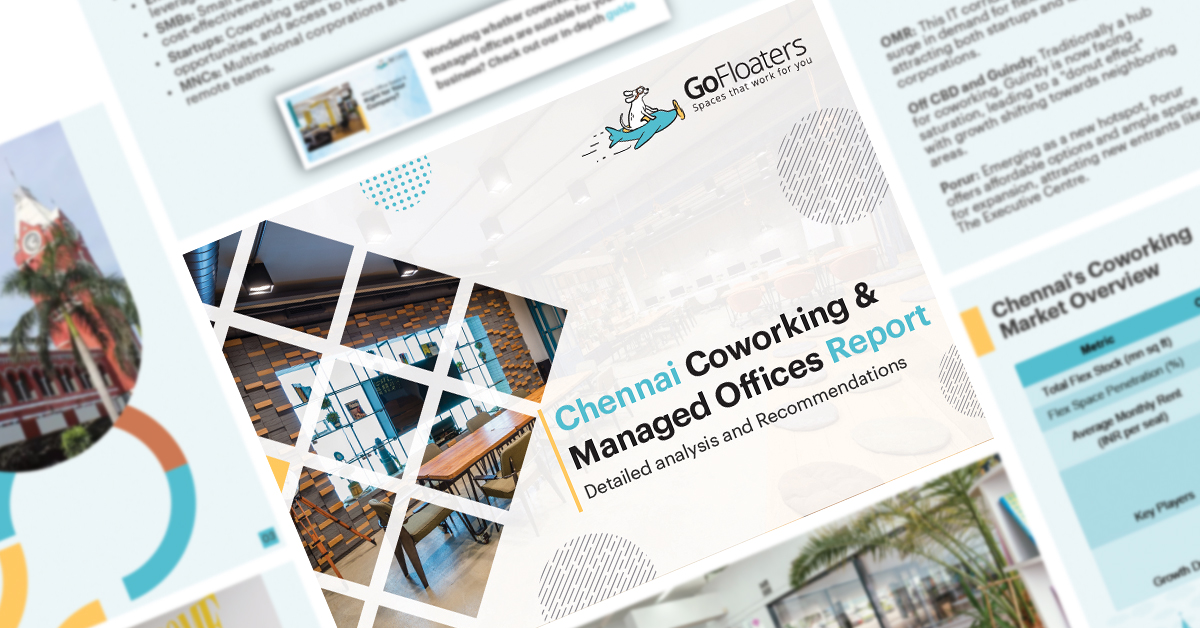Office space
Traditional Offices vs. Managed Offices - Which is Right for Your Business?
Shyam Nagarajan / Reading Time : 8 mins
The choice between a traditional office and a managed office can have a significant impact on how a business operates. Office space influences everything from employee productivity to business costs. In recent years, the debate between traditional offices and managed offices has become more relevant due to the growing need for flexibility in work environments.
Traditional offices have been the norm for decades, offering businesses full control over their workspace. Managed offices, on the other hand, provide businesses with ready-to-use spaces that come with services included. This shift in office space solutions reflects the changing demands of businesses and their employees.
"Managed offices offer scalability, operational ease, and predictable costs, while traditional spaces offer long-term control. Discover which model aligns better with your team’s needs and growth goals."
📑 Key chapter:
Let’s explore both models in detail and help you decide which is right for your business in this article.
Traditional & Managed Offices: Overview
A traditional office refers to a workspace owned or rented directly by a company. The business is responsible for setting up, designing, and maintaining the space.
Key features of traditional offices:
- Long-Term Leases: Businesses sign long-term leases, often ranging from five to ten years or even longer. This offers stability but can limit flexibility.
- Customization: The company has full control over how the space is designed. From the layout to the decor, everything reflects the brand’s identity.
- Ownership of Operations: Businesses handle all aspects of the office’s operation, including utilities, maintenance, and administrative tasks. This includes managing cleaning staff, tech support, and other essential services.
Managed offices are spaces provided by a third-party service provider. These offices are fully furnished, equipped, and serviced. Businesses simply move in and start working, with most operational tasks handled by the service provider.
Key features of managed offices:
- Flexible Leases: Managed offices offer flexible leasing options. Companies can rent spaces for short periods, such as a few months, making them suitable for businesses that require flexibility.
- Inclusive Services: Managed offices come with a range of services included. These often include internet, utilities, cleaning, reception, and maintenance, freeing businesses from operational duties.
- Easy Move-In: These spaces are designed to be plug-and-play, meaning businesses can start operating quickly without worrying about setup or infrastructure. Perhaps, you can ask the space owner for customization. You can amortize the customization cost using tips mentioned in this article.
Pros of Traditional Offices | Cons of Traditional Offices |
|---|---|
|
|
Pros of Managed Offices | Cons of Managed Offices |
|
|
Comparing Traditional Offices vs. Managed Offices
Let’s break down the key differences between traditional and managed offices to help you make an informed decision.
- Cost
Traditional offices require a high upfront investment. Companies must purchase furniture, set up IT infrastructure, and manage utilities. In contrast, managed offices offer a cost-effective solution, with all services included in one monthly fee. Businesses save on setup costs and only pay for the space and services they use. - Flexibility
Traditional offices are rigid in terms of lease agreements and space. If a business grows or downsizes, adjusting a traditional office can be difficult. Managed offices, on the other hand, offer short-term leases, allowing companies to scale as needed. This is ideal for businesses in their growth phase or those needing temporary office solutions. - Customization
In a traditional office, businesses have complete control over the design and layout. This allows companies to create a space that reflects their culture. Managed offices, while convenient, may not offer the same level of customization. Companies must often work within the design framework provided by the service. - Operational Responsibility
With traditional offices, businesses are responsible for the upkeep of the space. This includes managing repairs, maintenance, and cleaning. Managed offices take care of these tasks, allowing businesses to focus on their core activities. - Amenities
Traditional offices often require businesses to invest in amenities like meeting rooms, kitchens, and lounges. Managed offices come equipped with these amenities, which are shared among tenants. While this is convenient, businesses may need to compromise on scheduling or privacy in shared spaces. - Growth Potential
Businesses that anticipate rapid growth may benefit from the flexibility of managed offices. These spaces allow companies to expand without committing to long-term leases. Traditional offices, while stable, can limit growth due to fixed space and lease terms.
Who Should Choose a Traditional Office?
Traditional offices are ideal for businesses with long-term plans and specific needs. Here are some scenarios where a traditional office might be the best option:
- Established Companies: Companies that are well-established and foresee long-term stability often benefit from traditional offices. These businesses are more likely to invest in customizing their office space to align with their brand and operational requirements.
- Businesses with Specific Space Requirements: Certain industries, such as law firms or design agencies, may need customized office spaces. These businesses can fully control the layout and design in a traditional office, allowing them to meet their unique needs.
- Companies Seeking Stability: For businesses that prefer a fixed location and aren’t anticipating rapid changes, traditional offices offer long-term stability. This environment can be more comfortable for employees who thrive in consistent settings.
- Brand-Centric Organizations: If a company’s brand identity is closely tied to its physical office space, a traditional office provides the ability to create a branded environment. The design and layout can reflect the company’s values, boosting employee morale and leaving a lasting impression on clients.

Who Should Opt for a Managed Office?
Managed offices are best suited for businesses that need flexibility and convenience. Consider these scenarios where managed offices are the right choice:
- Startups: Startups and new businesses often benefit from managed offices because they require minimal upfront investment. These spaces provide everything a business needs to start operating without the hassle of setting up a traditional office.
- Growing Companies: For businesses that are rapidly expanding or expecting to scale, managed offices provide the flexibility to adjust the office size as needed. The ability to lease short-term spaces allows these businesses to adapt without committing to long-term leases.
- Organizations Focused on Core Activities: For businesses that prefer to focus on their core activities and outsource operational tasks, managed offices are a great solution. The service provider handles maintenance, cleaning, and other administrative duties, allowing the company to prioritize its primary goals.
Take a look at the managed offices report
View ReportTo know best coworking operators in India, watch this video:
Why GoFloaters Is The Best Office Space Provider in India?
GoFloaters is a leader in the office space market, offering flexible solutions tailored to meet the unique needs of businesses. Here’s why GoFloaters stands out in the crowded office space market:
- GoFloaters understands that businesses need flexibility. Whether you need a space for a few months or a longer-term commitment, GoFloaters offers customizable lease options that can scale with your business.
- When you choose GoFloaters, you get more than just a workspace. Their managed offices come with essential services such as high-speed internet, reception, cleaning, and IT support, ensuring that your business runs smoothly.
- With GoFloaters, businesses don’t have to worry about setting up the office. The spaces are fully equipped and ready for immediate use, which helps save time and money.
- GoFloaters offers office spaces in prime business districts, providing your company with a prestigious address. These locations are designed to attract both clients and employees, helping your business grow in the right environment.
- With GoFloaters, businesses can avoid the large upfront costs associated with traditional offices. The transparent pricing structure ensures that you only pay for what you use, making it an affordable option for businesses of all sizes.

